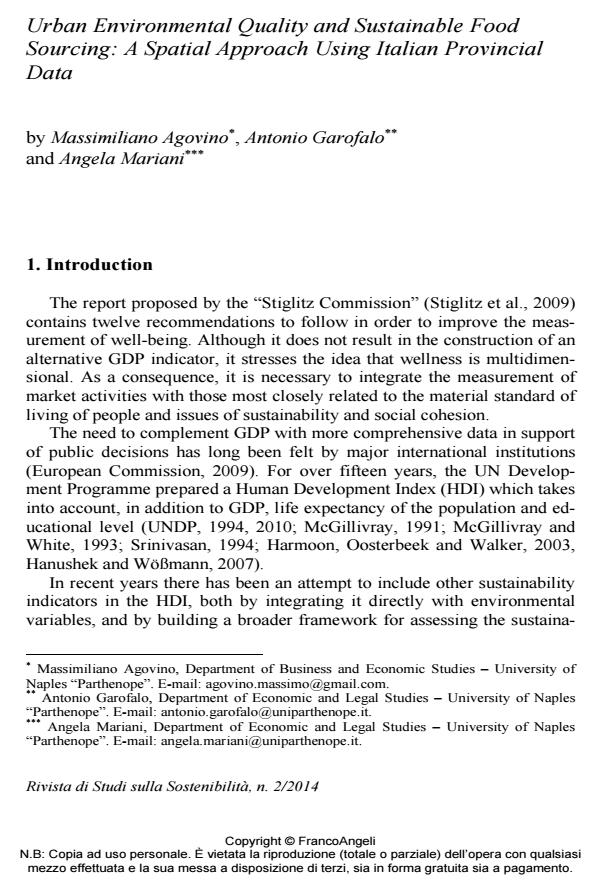Urban Environmental Quality and Sustainable Food Sourcing: A Spatial Approach Using Italian Provincial Data
Titolo Rivista RIVISTA DI STUDI SULLA SOSTENIBILITA'
Autori/Curatori Massimiliano Agovino, Antonio Garofalo, Angela Mariani
Anno di pubblicazione 2014 Fascicolo 2014/2
Lingua Inglese Numero pagine 19 P. 139-157 Dimensione file 285 KB
DOI 10.3280/RISS2014-002009
Il DOI è il codice a barre della proprietà intellettuale: per saperne di più
clicca qui
Qui sotto puoi vedere in anteprima la prima pagina di questo articolo.
Se questo articolo ti interessa, lo puoi acquistare (e scaricare in formato pdf) seguendo le facili indicazioni per acquistare il download credit. Acquista Download Credits per scaricare questo Articolo in formato PDF

FrancoAngeli è membro della Publishers International Linking Association, Inc (PILA)associazione indipendente e non profit per facilitare (attraverso i servizi tecnologici implementati da CrossRef.org) l’accesso degli studiosi ai contenuti digitali nelle pubblicazioni professionali e scientifiche
Environmental pollution affects human health and well-being, not only directly, but also indirectly due to its effects on food safety and urban and peri-urban agriculture. Proper indicators of urban environmental quality could improve the measurement of the health and well-being component of the Human Development Index. In this paper, by using the Legambiente Index and the Local Moran Transition Probability Matrix, we assess and compare the performance of Italian provinces’ in providing urban environmental quality. Results show a persistent dualism between Northern and Southern Italy and the absence of positive environmental spillover among neighboring provinces. In Southern Italy, policymakers should focus more on improving sustainable food sourcing for a more sustainable and resilient urban development.
L’inquinamento urbano influenza salute e benessere in modo diretto ed indiretto perché mette a rischio la sicurezza degli alimenti e l’agricoltura urbana e periurbana. Indicatori di qualità ambientale urbana potrebbero migliorare la misurazione della componente salute e benessere dell’Indice di Sviluppo Umano. In questo articolo, utilizzando l’Indice di Legambiente, analizziamo e confrontiamo (Matrice della Probabilità di Transizione di Moran) la performance delle province italiane nel garantire la qualità ambientale. I risultati mostrano un netto dualismo tra Nord e Sud e l’assenza di spillover positivi tra province contigue. Nel Sud, i responsabili politici dovrebbero incentivare un approvvigionamento alimentare sostenibile per uno sviluppo urbano più sostenibile e resiliente.
Parole chiave:Qualità ambientale; matrice delle probabilità di transizione locali di moran; statistica spaziale; indice di Legambiente; diffusione spaziale; analisi esplorativa dei dati spaziali (AEDS)
- Estimating urban food waste at the local level: are good practices in food consumption persistent? Massimiliano Cerciello, Massimiliano Agovino, Antonio Garofalo, in Economia Politica /2019 pp.863
DOI: 10.1007/s40888-017-0089-8 - The role of cultural consumption in reducing social exclusion: empirical evidence from Italy in a spatial framework Aniello Ferraro, Massimiliano Cerciello, Massimiliano Agovino, Antonio Garofalo, in Economia Politica /2019 pp.139
DOI: 10.1007/s40888-019-00144-w - Cancer mortality rates and spillover effects among different areas: A case study in Campania (southern Italy) Massimiliano Agovino, Maria Carmela Aprile, Antonio Garofalo, Angela Mariani, in Social Science & Medicine /2018 pp.67
DOI: 10.1016/j.socscimed.2018.03.027
Massimiliano Agovino, Antonio Garofalo, Angela Mariani, Urban Environmental Quality and Sustainable Food Sourcing: A Spatial Approach Using Italian Provincial Data in "RIVISTA DI STUDI SULLA SOSTENIBILITA'" 2/2014, pp 139-157, DOI: 10.3280/RISS2014-002009